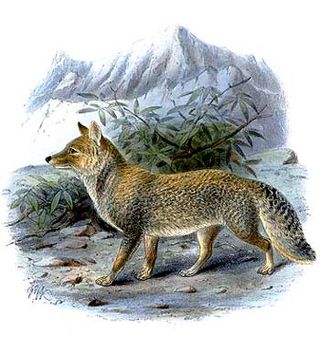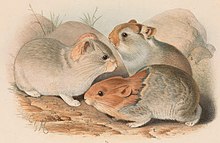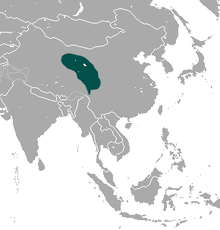
A pika is a small, mountain-dwelling mammal native to Asia and North America. With short limbs, a very round body, an even coat of fur, and no external tail, they resemble their close relative, the rabbit, but with short, rounded ears. The large-eared pika of the Himalayas and nearby mountains lives at elevations of more than 6,000 m (20,000 ft).

The Tibetan fox, also known as the Tibetan sand fox, is a species of true fox endemic to the high Tibetan Plateau, Ladakh plateau, Nepal, China, Sikkim, and Bhutan, up to elevations of about 5,300 m (17,400 ft). It is listed as Least Concern in the IUCN Red List, on account of its widespread range in the Tibetan Plateau's steppes and semi-deserts.

The Chinese zokor is a species of rodent in the family Spalacidae. It is endemic to China, ranging from Qinghai Province eastwards to Beijing in steppe and alpine grasslands. Henri Milne-Edwards first described it in 1867. Eradication programs in the 1990s in Qinghai Province resulted in a population decline to less than a third of the former population. It is considered common and has been assessed as Least Concern by IUCN.

The alpine pika is a species of small mammal in the pika family, Ochotonidae. The summer pelage of different subspecies varies drastically but, in general, it is dark or cinnamon brown, turning to grey with a yellowish tinge during the winter. The alpine pika is found in western Mongolia, eastern Kazakhstan, and Russia, as well as in China, in very cold, mountainous regions. It is a generalist herbivore, and mainly forages on mosses, tree branches, pine nuts, and plant stems. It can emit three series of different vocalizations: a long call, a short call, and an alarm call. It is rated as a species of least concern on the IUCN Red List of Endangered Species.

The Helan Shan pika or silver pika is a species of mammal in the pika family, Ochotonidae. It is endemic to China where it is found in a small region of the Helan Mountains. It is listed as "Endangered" in the IUCN Red List of Threatened Species as of 2016.

The plateau pika, also known as the black-lipped pika, is a species of mammal in the pika family, Ochotonidae.

The Daurian pika is a small relative of rabbits and hares in the order Lagomorpha. It is well known for its “barking” alarm call, and for its peculiar habit of making hay to help survive the winter. There are 4 recognized subspecies, Ochotona dauurica annectens, O.d. bedfordi, O.d. dauurica, and O.d. mursavi. Daurian pikas, like other lagomorphs, are characterized by a secondary set of incisor teeth. They are sexually monomorphic, with thick reddish coats. Pikas have no external tail, and their ears are large and rounded. The auditory bullae, a feature of the skull of daurian pikas are small in comparison to many other pikas. This is thought to be related to their fairly low altitude habitat preference. They are considered keystone species within their habitat.

Forrest's pika is a species of mammal in the pika family, Ochotonidae. It is found in Bhutan, China, India, and Myanmar. The summer dorsal pelage and ventral pelage are dark rufous or blackish brown, and the winter dorsal pelage is a grayish brown, slightly lighter in tone than the ventral pelage. It is a generalist herbivore. It was assessed by the IUCN Red List of Endangered Species as insufficiently known in 1994, as near threatened in 1996, and re-assessed in 2008 as a species of least concern.

The Gaoligong pika is a species of mammal in the family Ochotonidae. It is endemic to China. Many of the general physical characteristics of the pika species, are shared by Gaoligong pikas. However, the Gaoligong pika is specifically characterized by unique physical characteristics, including a red-brown colored crown around the neck and black behind the ears. They can produce one litter per year and can live up to three years. Their behavior is currently undetermined due to limited information available about the species. This is due to the inaccessibility of their habitat.

Glover's pika is a species of mammal in the family Ochotonidae. It was first described in 1922, by Michael Rogers Oldfield Thomas. The summer dorsal pelage is grayish rufous, grayish brown, or tea brown in colour. The winter pelage is similar to the summer pelage, but is lighter in tone. Endemic to China, it is found in high altitudes of northeastern Tibet, southwestern Qinghai, western Sichuan, and northwestern Yunnan. It is a generalist herbivore, and is known to construct haypiles. It is rated as a species of least concern by the International Union for Conservation of Nature. It is also regionally red listed as least concern in China.

The Himalayan pika is a species of small mammal in the pika family (Ochotonidae). It is found at high altitudes in remote areas of Ladakh, Uttarakhand and possibly also in Nepal &Tibet. The IUCN has listed this species as being of "least concern".

The Ladak pika, also known as the Ladakh pika, is a species of mammal in the family Ochotonidae found in China, India, and Pakistan. Prior to identification as a separate species, specimens were thought to be of the plateau pika. Named for the Ladakh region, they are commonly found in valleys of the mountain ranges spanning from Pakistan through India to China at an elevation between 4,300 and 5,450 m and are herbivores.

The large-eared pika is a species of small mammal in the family Ochotonidae. It is found in mountainous regions of Afghanistan, Tibet, Bhutan, India, Kazakhstan, Kyrgyzstan, Nepal, Pakistan and Tajikistan where it nests among boulders and scree.

The Afghan pika is a species of small mammal in the pika family, Ochotonidae. It is found in Afghanistan, Iran, Pakistan and Turkmenistan and the IUCN lists it as being of "least concern".

The Turkestani red pika is a species of mammal in the family Ochotonidae. The summer fur at its back is bright rufous and the ventral fur is white or ochraceous. The winter dorsal fur is pale brown and the ventral fur is white or light ochraceous in colour. It is found in the mountains of western Xinjiang in China, and sporadically also in the central Asian mountains in Kazakhstan, Kyrgyzstan, Tajikistan, and Uzbekistan. The female has a low fertility rate, and gives birth to offspring during the breeding season from spring to summer. She generally produces two litters each year, with two to six young. It is rated as a species of least concern on the International Union for Conservation of Nature Red List of Endangered Species, but it is considered to be near-threatened within the China part of its range.

The Moupin pika, also known as Ribetischer Pika, Moupin-Pika, Pika del Tibet, and Manipuri pika, is a species of mammal in the pika family, Ochotonidae. It has many subspecies, some of which may be distinct species. Its summer pelage is dark russet-brown with some light spots on the dorsal side, and ochraceous buff tinged on the belly. In winter it is lighter, with buff to dull brown dorsal pelage. A generalist herbivore, it is found in the mountains of the eastern Tibetan Plateau in China, Bhutan, India (Sikkim), and northern Myanmar. Both the International Union for Conservation of Nature Red List of Endangered Species and the Red List of China's Vertebrates classify it as a species of least concern; although one subspecies may be endangered.

Thomas's pika, also known as the Thomas-pika, is a species of small mammal in the pika family, Ochotonidae. The fur on its upper body is reddish brown in summer, and mouse grey in winter. It is a generalist herbivore threatened by habitat loss, being found on isolated peaks of the eastern Qilian Mountains in Qinghai, Gansu, and northwestern Sichuan, in China. The International Union for Conservation of Nature Red List of Endangered Species assessed the animal as insufficiently known in 1994, as near threatened in 1996, and as a species of least concern in 2008.

Pallas's pika, also known as the Mongolian pika, is a species of small mammals in the pika family, Ochotonidae. It is found mainly in the mountains of western Mongolia.




















